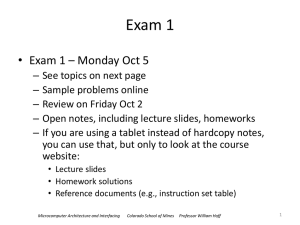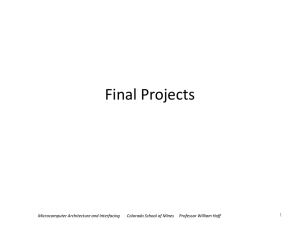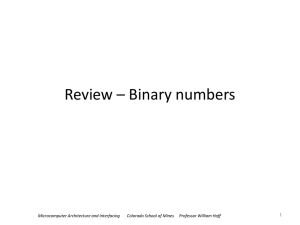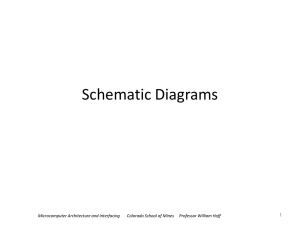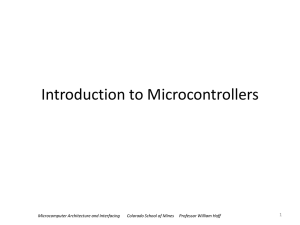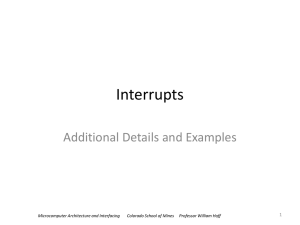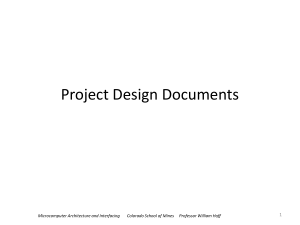State Machines
advertisement
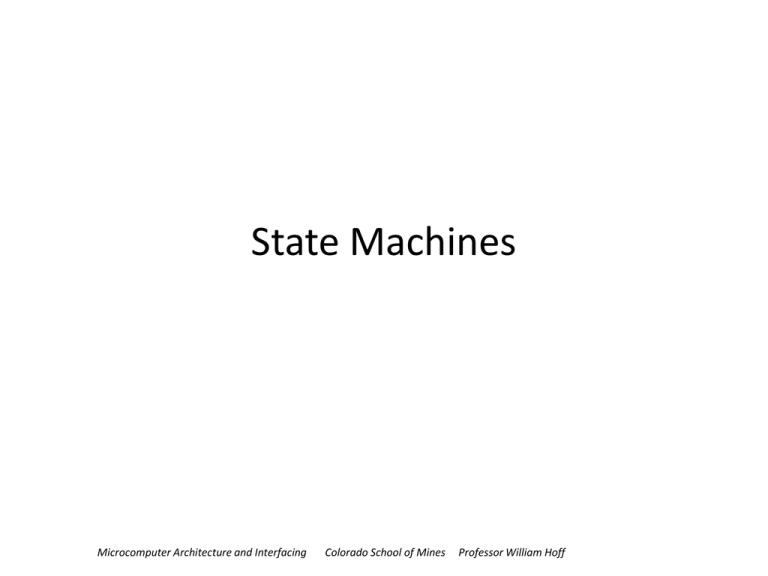
State Machines
Microcomputer Architecture and Interfacing
Colorado School of Mines
Professor William Hoff
State Machines
• State machines provide a
convenient way to model the
dynamic behavior of systems
– Many applications naturally are
represented with a set of
discrete states
– Complicated systems can be
broken down into multiple
hierarchical state machines
• State machines can be
implemented in hardware or
software
– We’ll show how to implement
them in software
Microcomputer Architecture and Interfacing
Colorado School of Mines
Professor William Hoff
2
State machines in hardware
• A state machine consists of
– a state memory
– some output logic
– some excitation logic that determines the next state
• At each tick of the clock, the system changes state depending on
the inputs to the excitation logic and the current state
– While in a state, the outputs are held steady (for a Moore machine)
and are just a function of the current state
inputs
Excitation logic
State
memory
Output logic
outputs
Q
Clock
Microcomputer Architecture and Interfacing
Colorado School of Mines
Professor William Hoff
3
State machines in software
• We represent the state with a single variable called the state
variable
• We simulate the regular ticking of the clock with an infinite
loop that runs at regular intervals
• Within one iteration of this loop, we determine the current
state, set the outputs for this state, and determine the next
state
• In C, this can be done with a switch statement, or a set of ifthen-else statements, inside a loop
Microcomputer Architecture and Interfacing
Colorado School of Mines
Professor William Hoff
4
Generic state machine pseudo code
Set initial value of state variable
Do all other initialization
WHILE (TRUE) DO
wait until start of next clock period
IF (STATE = STATE1) THEN
do outputs for this state
determine next value of STATE
ELSE IF (STATE = STATE2) THEN
do outputs for this state
determine next value of STATE
ELSE IF (STATE = STATE3) THEN
do outputs for this state
determine next value of STATE
:
Microcomputer Architecture and Interfacing
Colorado School of Mines
Professor William Hoff
5
Example – elevator controller
• The elevator goes between
two floors, F1 and F2
B’
F2
B
S
S’
• The controller has two
control inputs:
S’
S
B
– S is a sensor signal that is
asserted when the elevator
has arrived at a floor
– B is a button signal that is
asserted when the elevator
is supposed to go to the
other floor
Microcomputer Architecture and Interfacing
DN
UP
F1
B’
State
F2
DN
F1
UP
Colorado School of Mines
Description
At floor 2
Going down...
At floor 1
Going up...
Professor William Hoff
Output
command motor off
command motor down
command motor off
command motor up
6
Pseudo code
Initialize STATE to F1
WHILE (TRUE) DO
IF (STATE = F1) THEN
Command motor off
IF (B) THEN
STATE = UP
ELSE IF (STATE = UP) THEN
Command motor to go up
IF (S) THEN
STATE = F2
ELSE IF (STATE = F2) THEN
Command motor off
IF (B) THEN
STATE = DN
ELSE IF (STATE = DN) THEN
Command motor to go down
IF (S) THEN
STATE = F1
ELSE
invalid state - try to recover
Microcomputer Architecture and Interfacing
/* actions for this state */
/* next state logic */
B’
F2
B
S
/* actions for this state */
/* next state logic */
S’
DN
UP
S’
S
B
/* actions for this state */
/* next state logic */
F1
B’
/* actions for this state */
/* next state logic */
Colorado School of Mines
Professor William Hoff
7
Elevator controller (continued)
+5V
HCS12
• Hardware connections
S
PT3
– PT0,PT1: control H-bridge to
drive motor
– PT2: button input B
– PT3: sensor input S
+5V
PT2
B
PT1
PT0
H
bridge
M
• Loop time interval
– Use RTI system
– Use interval of 1/8 sec
Microcomputer Architecture and Interfacing
• Assume
– PT1:PT0 = 1:0 drives motor
to go up
– PT1:PT0 = 0:1 drives motor
to go down
Colorado School of Mines
Professor William Hoff
8
/*********************************************
State machine program
Bill Hoff
*********************************************/
#include <hidef.h>
/* common defines and macros */
#include "derivative.h" /* derivative-specific definitions */
C code
(1 of 2)
// Define our states
#define F1 0
// at floor 1
#define UP 1
// going up
#define F2 2
// at floor 2
#define DN 3
// going down
void main(void) {
char state;
/* Set up RTI system for the slowest count rate.
The Osc-clock is divided by (N+1)*2^(M+9), where
N = 0..15, M=0..7
So the slowest rate is when N=15, M=7.
The 8 MHz clock is divided by 16x2^16 = 2^20 = 1048576.
*/
RTICTL = 0x7f; // RTI will time out about every 1/8 sec
DDRT = 0x03;
// PT1,PT0 are outputs to H-bridge
EnableInterrupts;
Microcomputer Architecture and Interfacing
Colorado School of Mines
Professor William Hoff
9
state = F1; // assume that we start at floor 1
for(;;) {
// Wait till RTI flag is set
while (! (CRGFLG & 0x80))
;
// RTIF is bit 7
CRGFLG = 0x80;
// clear flag
switch (state) {
case F1:
// At floor 1
PTT = 0x00;
// Turn motor off
if (PTT & 0x04) // Check (B) button pushed
state = UP; // Next state is: go up
break;
case UP:
// Going up
PTT = 0x02;
// Command motor to go up
if (PTT & 0x08) // Check (S) if we are at floor
state = F2; // Next state is: at floor F2
break;
case F2:
// At floor 2
PTT = 0x00;
// Turn motor off
if (PTT & 0x04) // Check if button pushed
state = DN; // Next state is: go down
break;
case DN:
// Going down
PTT = 0x01;
// Command motor to go down
if (PTT & 0x08) // Check (S) if we are at floor
state = F1; // Next state is: at floor F1
break;
default:
// invalid state
state = F1;
// should reset?
}
_FEED_COP(); /* feeds the dog */
} /* loop forever */
C code
(2 of 2)
}
Microcomputer Architecture and Interfacing
Colorado School of Mines
Professor William Hoff
10
Issues
• This was a simple example and there are some factors you would need to
deal with in a real system, such as
• Initialization and resetting
– The elevator does not necessarily start at floor 1
– You could use another sensor to figure out its true location
– Or, you could have a separate initialization sequence of states to put it into a
known location
• Transition from “at floor” to “moving”
– Assume elevator is at a floor and you command the motor to start moving
– The elevator may not leave the floor (ie., S is still asserted) before the next
iteration; therefore you would incorrectly deduce that the elevator already
reached its destination
– Fixes?
Microcomputer Architecture and Interfacing
Colorado School of Mines
Professor William Hoff
11
Example – combination lock
• A user must enter four numbers to open a combination lock
• After all four numbers have been entered, the system asserts either the
OPEN signal (if the correct combination was entered) or the ERR signal
(if any of the numbers was incorrect)
• Note that the machine must wait until all four digits have been entered
before asserting either OPEN or ERR
Reset
1
EQ
S0
EQ
S1
EQ’
EQ
S2
EQ’
EQ’
S1A
S4
EQ’
S2A
1
EQ
S3
S3A
1
S4A
1
• OPEN is asserted
in state S4
• ERR is asserted in
state S4A
• There is an
asynchronous
RESET signal
1
Microcomputer Architecture and Interfacing
Colorado School of Mines
Professor William Hoff
12
Example – traffic light controller
• Intersection has
stoplights for
North
– North-south traffic
(NR,NY,NG)
– East-west traffic
(ER,EY,EG)
NS
NR NY NG
ER
EY
EG
ER
EW
• Sensors
– NS asserted if a car is
waiting to go north or
south
– EW asserted if a car is
waiting to go east or west
Microcomputer Architecture and Interfacing
Colorado School of Mines
East
EY
EG
EW
NR NY NG
NS
Professor William Hoff
13
Example – traffic light controller
• Outputs
North
– NR,NY,NG,ER,EY,EG
• Inputs
NS
– NS,EW
NR NY NG
ER
• Outputs should sequence
through
–
–
–
–
–
–
–
NR, EG
NR, EY
NR, ER
NG, ER
NY, ER
NR, ER
(and then repeat)
Microcomputer Architecture and Interfacing
EY
EG
ER
EW
East
EY
EG
EW
NR NY NG
NS
Colorado School of Mines
Professor William Hoff
14
Example – traffic light controller
• A stoplight is green for
minimum time TG1
North
– After TG1, if a car is
waiting in the other
direction, switch to other
direction green
– If no car waiting, stay
green for a total
maximum time TG2
NS
NR NY NG
ER
EY
EG
ER
EW
• Yellow is on for time TY
East
EY
EG
EW
NR NY NG
NS
• Both reds are on for
time TR
Microcomputer Architecture and Interfacing
Colorado School of Mines
Professor William Hoff
15
Timing
• We will need a timer to time how long we are in each state
• We will use a variable called t, and increment it every time
through the main iteration loop
– We just compare t to TG1, TG2, TY, or TR
– The values TG1, TG2, etc are specified in terms of main loop counts
• Let’s say that we use the RTI system to time the main loop, at
say a rate of 8 Hz
– Then a time of say, 15 seconds, corresponds to 8*15 counts
Microcomputer Architecture and Interfacing
Colorado School of Mines
Professor William Hoff
16
State diagram
Links are labeled with:
expression; action
t<=TG1
t>TR;
reset t=0
t<=TR
S0
S7
(t>TG2) || EW;
reset t=0
S2
S6
(t>TG1)
&& !NS
t>TR;
reset
t=0
S4
S0
NG ER (1st period)
S1
NG ER (2nd period)
S2
NY ER
S3
NR ER
S4
NR EG (1st period)
S5
NR EG (2nd period)
S6
NR EY
S7
NR ER
•
Timer counter t is reset
when transitions are
made
•
Since action happens on
a transition, this is a
Mealy machine
S3
S5
Outputs
t<=TY
t>TY;
reset t=0
(t>TG1) && NS;
reset t=0
(t>TG2) || NS;
reset t=0
(t>TG1)
&& !NS
(t<=TG2)
&& !EW
S1
(t>TG1)
&& EW;
reset t=0
t>TY;
reset t=0
t<=TY
(t>TG1)
&& !EW
State
t<=TR
t<=TG1
Microcomputer Architecture and Interfacing
Colorado School of Mines
Professor William Hoff
17
Traffic light system (continued)
HCS12
• Hardware connections
– PT5:PT0: outputs to lights
– PT6:PT5: inputs from sensors
PT7
PT6
EW
NS
PT5
ER
EY
PT4
PT3
// Define masks for
#define NG 0x01
#define NY 0x02
#define NR 0x04
#define EG 0x08
#define EY 0x10
#define ER 0x20
the output bits
// PT0
// PT1
// PT2
// PT3
// PT4
// PT5
PT2
EG
NR
PT1
PT0
NY
NG
// Define masks for the input bits
#define NS 0x40
// PT6
#define EW 0x80
// PT7
Microcomputer Architecture and Interfacing
Colorado School of Mines
Professor William Hoff
18
Traffic light system (continued)
• State declarations
// Define our states
#define S0 0
// North
#define S1 1
// North
#define S2 2
// North
#define S3 3
// North
#define S4 4
// North
#define S5 5
// North
#define S6 6
// North
#define S7 7
// North
green, east red (1st
green, east red (2nd
yellow, east red
red, east red
red, east green (1st
red, east green (2nd
red, east yellow
red, east red
period)
period)
period)
period)
• Time interval declarations (assume RTI period is 8 Hz)
// Define times (in
#define TG1 15*8
#define TG2 30*8
#define TY
5*8
#define TR
3*8
units of RTI timer counts)
// 1st green period = 15 sec
// 2nd green period = 30 sec
// Yellow = 5 sec
// Both red = 3 sec
Microcomputer Architecture and Interfacing
Colorado School of Mines
Professor William Hoff
19
